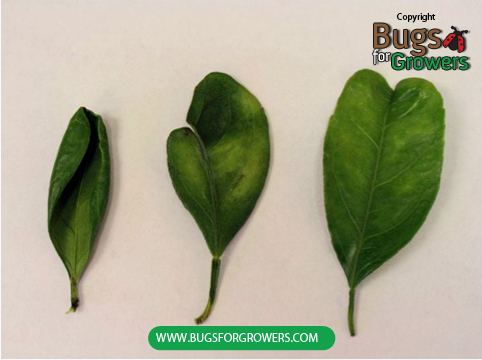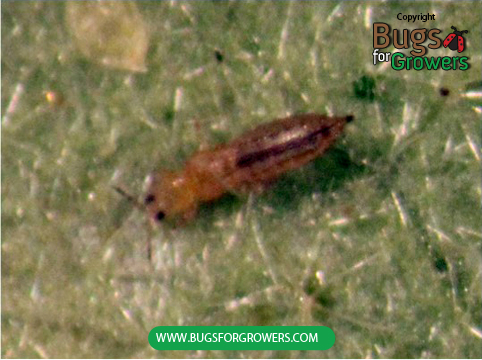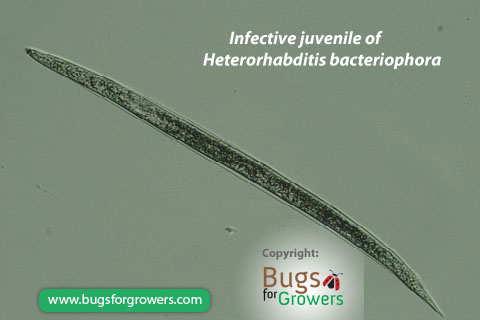Damage caused by the western flower thrips
The western flower thrips (Frankliniella occidentalis) are one of the most damaging pests of many crops, ornamental plants, field crops and fruits. Both adults and nymphs of mites feed directly on the young succulent leaves, flowers and small fruits using their rasping and sucking types of mouthparts. Feeding damage caused by thrips generally leaves scars (stippling) on the buds, leaves, flowers, fruits and twigs. The symptoms caused by thrips include stunted plant growth, curling/folding (Photo 1) and discoloration of leaves, and flowers. These damaged plant parts can drop prematurely. Also, the scattered thrip feces on the leaves and flowers can reduce aesthetic value of ornamental plants causing a tremendous economic loss to the greenhouse industry. The western flower thrips are also known to transfer plant viruses that can cause severe yield losses to many crops and aesthetic value of many ornamental plants.

Identification of the western flower thrips
The western flower thrips are small slender bodied insects with brownish colored body and yellowish hair-fringed wings. The babies of the western flower thrips are called as nymphs (Photo 2) that look like their parents but they are wingless. Both adults and nymphs of thrips have rasping and sucking types of mouthparts that they use for puncturing tissues and sucking the cell sap (juice) from the punctured tissues.

Life cycle of the western flower thrips
The western flower thrips can reproduce sexually or asexually and their females generally insert eggs into leaf or bud tissues. Eggs hatch into tiny first stage larvae that immediately starts feeding on plant tissue. While feeding, young larvae molt into second stages that continue feeding on the leaf tissues until they become mature. The matured larvae then enter into the non-feeding pre-pupal stages that drop off to the soil for pupation. Adult thrips emerge from these pupae, then females met and begin laying eggs and life cycle continues. Depending upon temperature, egg to egg life cycle is completed within 10 to 20 days and under warm weather conditions, thrips can complete more than 10 generations in a year.
Biological control of the western flower thrips, Frankliniella occidentalis
Simultaneous application of both beneficial entomopathogenic nematodes like Heterorhabditis bacteriophora (see below) and predatory mites like Amblyseius (Neoseiulus) cucumeris (see below) is a very effective method of controlling the western flower thrips. This is because the predatory mites when applied to the surface of the leaves, they will feed on all the immature stages of thrips and when Heterorhabditis bacteriophora nematodes simultaneously applied to the surface of the soil, they will find and feed on all the pre-pupal and pupal stages of the thrips. This means both nematodes and predatory mites when applied at the same time, they will disrupt the life cycle of the thrips by killing their both immature and mature stages and pupae and stop the future reproduction of the western flower thrips.
What are Heterorhabditis bacteriophora nematodes?
Beneficial Heterorhabditis bacteriophora nematodes (Photo 3) are tiny roundworms that use “cruise foraging” strategy in which their infective juveniles actively move to find their hosts like pre-pupal and pupal stages of the western flower thrips throughout the soil profile and feed on them.

How do Heterorhabditis bacteriophora nematodes kill thrips?
When the infective juveniles of Heterorhabditis bacteriophora are applied to the soil surface, they start searching for their insect hosts. Once they find their host, the nematode infective juveniles will penetrate into the host’s body cavity via natural openings like mouth anus and breathing pores. Then they enter into host body cavity and release their symbiotic bacteria, Photorhabdus luminescens in the insect blood. In the blood, multiplying nematode-bacterium complex causes septicemia and kill their insect host like pupae of thrips usually within 24-48 hours after infection.
How many Heterorhabditis bacteriophora nematodes should be applied to kill thrips?
The optimum rate for the effective control of thrips is 23,000 H. bacteriophora nematodes per square foot area. Use following table to apply correct numbers of nematodes per square foot area for the effective control of the western flower thrips.
Area in sq. ft. = Number of nematodes required
1sqft = 23,000 nematodes
100 sqft = 2,300,000 nematodes
500 sqft = 11,500,000 nematodes
1,000 sqft = 23,000,000 nematodes
43,560 sqft (1 Acre) = 1,000,000,000 nematodes
What are Predatory, Amblyseius (Neoseiulus) cucumeris mites?
Predatory, Amblyseius (Neoseiulus) cucumeris are very small about 0.5 mm in size, pear shaped and tan colored mites that are currently used as beneficial biological control agents for the control of different species of thrips including the western flower thrips. These mites are active feeders of thrips and keep feeding on them until they die.
How many Predatory, Amblyseius (Neoseiulus) cucumeris mites should be applied to kill thrips?
The predatory mite, Neoseiulus cucumeris can be used both as both preventive and curative control measures for the thrips. As a preventive treatment, mites can be released even before the incidence of thrips in your garden, as these mites can survive by feeding on pollen until they can find their real food, the thrips. As a curative control measure, these predatory mites should be released when there is a high population of thrips present on the plants in your garden.
- For low incidence of thrips or as preventive control, release 50-60 mites per square meter area.
- For medium incidence of thrips, release about 100 mites per square meter area.
- For high incidence of thrips or as curative control strategy, release more than 100 mites per square meter area.
How to release Neoseiulus cucumeris mites?
These mites are sold in bulk quantity in a bran flake substrate that can be evenly spread over the foliage of crop or over the seedlings before transplanting. When these predatory mites are supplied in small packages, open the boxes and shake them for even distribution of mites on the surface of plants in the garden.
References
- Ebssa, L., Borgemeister, C. and Poehling, H-M. 2006. Simultaneous application of entomopathogenic nematodes and predatory mites to control western flower thrips Frankliniella occidentalis. Biological Control 39: 66-74.
